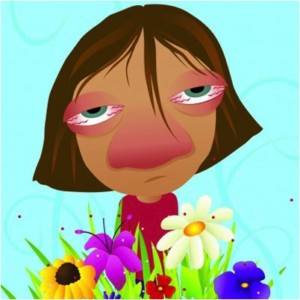While many people living with seasonal allergies will wait until symptoms are present to seek relief, beginning an herbal treatment 6 weeks before the allergy season begins can effectively prevent seasonal allergy symptoms all together. Each spring, more than 50 million Americans will endure symptoms related to seasonal allergies. While many will turn to over-the-counter allergy medications for relief, these drugs often loose their efficacy and can even worsen symptoms over time. Botanical medicine offers an alternative approach, providing powerful symptom relief from seasonal allergy symptoms throughout the season without adverse effects. Taken alone, or in combination, these top 10 botanical medicinal herbs prevent and alleviate symptoms of seasonal allergies while supporting the body with tonifying, nutritive, and soothing effects.

- Urtica dioica: Otherwise known as stinging nettle, it is the leaf of this plant that provides powerful allergy relief. Biochemical constituents including chlorophyll, indoles, and acetylcholine. High amounts of vitamins and minerals provide antihistamine, cleansing, and nutritive effects on the body. This herb is particularly useful for allergy symptoms such as sneezing, runny or stuffy nose, and swelling around the eyes.
- Euphrasia officinalis: The tannin compounds of this herb, also known as eyebright, contribute to its astringent, and anti-inflammatory properties. As the name may suggest, this herb provides rapid relief from red, itchy, and swollen eyes, restoring clarity of vision. Eyebright’s ability to constrict vessels also provides relief of symptoms such as stuffy nose, sinus congestion and pressure, and the feeling of “running like a faucet”.
- Solidago odora: Unlike its neighbor, ragweed, which is often the cause of seasonal allergies, this plant is insect pollinated rather than wind pollinated. Solidago, or golden rod, has diuretic and analgesic effects, among others. These actions make golden rod an excellent choice for seasonal allergies with congestion and swelling, due to its ability to help the body eliminate the fluid causing these symptoms.
- Scutallaria lateriflora: With its antispasmodic ability from its effect on prostaglandin and leukotriene pathways in the body, Scutallaria, or skullcap, is a fantastic herb for those who experience a spasmodic cough or allergic asthma symptoms during the allergy season. Skullcap also inhibits the cyclooxygenase pathway, similar to how aspirin works, making it the go-to herb for those experiencing migraine headaches during allergy season. Because of its strong affinity for the nervous system, skullcap calms a stressed body that has been busy coughing, sneezing, and suffering from seasonal allergies.
- Petasites hybridus: In clinical studies, Petasites hybridus, or Butterbur, was shown to be as effective as the common over-the-counter allergy medication known as Allegra in relieving nasal congestion, itchy eyes and nose, red eyes, and skin irritation. Butterbur is particularly known for its ability to inhibit the production of leukotrienes, a group of compounds found to produce bronchoconstriction, resulting in asthma symptoms and spastic coughs.
- Glycerrhiza glabra: The sweet, pleasant taste of Glycerrhiza, or licorice, makes it particularly useful for children during allergy season. The extract from the root of this plant soothes mucous membranes and respiratory passages, providing relief from cough, wheezing, as well as throat and bronchial irritations. Antihistamine and detoxifying properties result in an overall reduction of histamine in the body by stabilizing mast cells and supporting the body’s elimination process.
- Rumex Crispus: Also known as yellow dock, it is this herb’s alterative, astringent, and tonifying actions that make it a top herbal pick for the treatment of coughs related to allergies. Particularly a dry, irritating cough, or a cough produced by a tickle in the throat. Yellow dock is also a wonderful herb to help cleanse the blood of impurities, such as histamine, while providing nutrients, such as vitamin A, to help boost immune function.
- Grindelia robusta: The common name of this herb, gum plant, may help describe the symptoms it helps relieve; sticky, gummy congestion with a strong affinity for the respiratory tract. Those in need of some gum plant may experience a harsh, dry cough, and asthmatic breathing with a sense of soreness and rawness. Grindelia’s expectorant and antispasmodic properties provide relief by supporting the body to eliminate the “gum” and reducing smooth muscle spasms in the bronchial musculature.
- Asclepias tuberosa: With a strong affinity for the lungs, it should not be surprising to find the Latin word, pleurae, describing the thin membrane surrounding the lungs, in the common name for this herb; Pleurisy root. The root of the Asclepias plant provides diaphoretic, expectorant and antitussive actions. These actions make pleurisy root an excellent choice when treating nasal congestion, cough, and asthma symptoms associated with seasonal allergies.
- Sambucus Canadensis: While Sambucus, also known as elderberry, may be more widely known for the treatment of cold and flu, it is the flowers, not the berries that provide powerful seasonal allergy relief. The flowers of the Sambucus plant produce diaphoretic and diuretic actions by separating epidermis, and releasing serum and excess fluid. These actions relieve swelling and puffiness in the eyes, nose, throat, and any other parts of the body retaining fluid.
Allergy season can be a miserable time of year for many of Americans, but it doesn’t have to be. Starting a regimen 6 weeks before the season begins is the best way to prevent seasonal allergy symptoms. This year, enjoy spring and summer without suffering from seasonal allergies with help from botanical medicine. While you may be able to find forms of these herbs in drug stores, only a Naturopathic Doctor can provide you with the highest-quality, pharmaceutical grade medicinal herbs to ensure optimal efficacy. Make an appointment with one of the Naturopathic Doctors at Bhakti Wellness Center today, so you can enjoy the natural beauty of the season, rather than living in the “histamine haze” of seasonal allergies.
